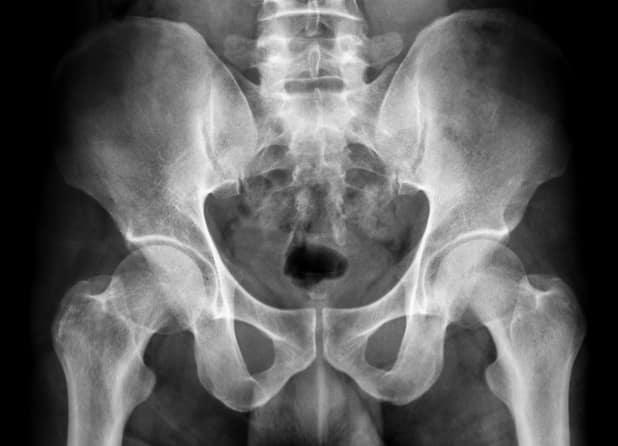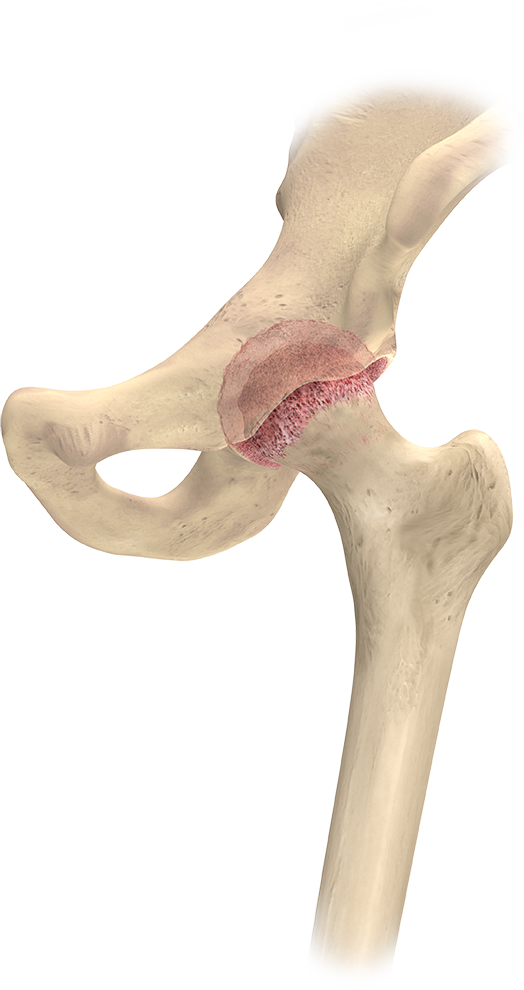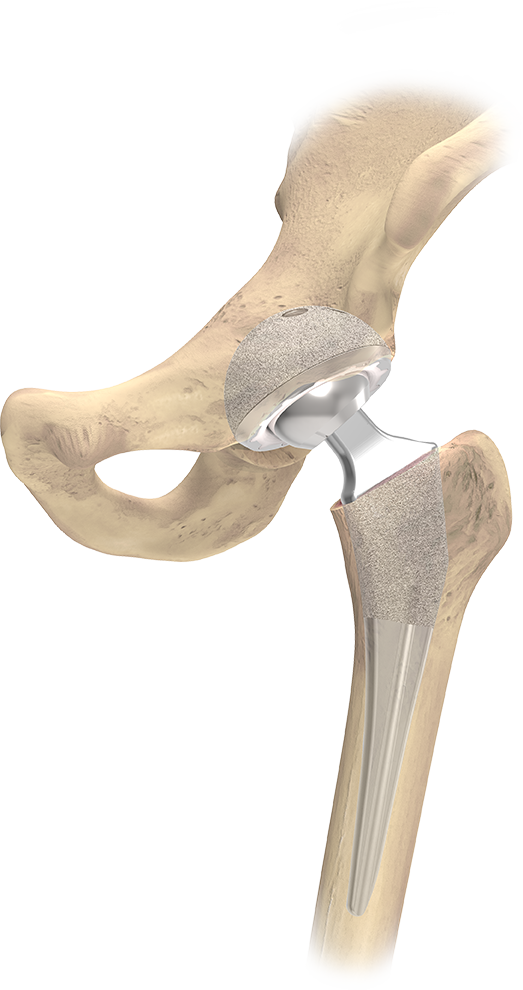
Get Back Living Life
Without Hip Pain

Total Hip Replacement
The hip is a simple ball-and-socket joint where the thigh bone joins with the pelvis. The hip is the largest weight-bearing joint1 in the human body and is supported by muscles, cartilage, and ligaments. These structures surrounding the hip help to cushion the joint and allow it to work smoothly without pain.
A hip may become diseased with arthritis or injured during a fall, which may reduce mobility and may cause pain during movement or even at rest. When arthritis wears away the cartilage, the hip bones may start rubbing together, which can be painful and may cause damage to the surface of the bones.The damaged bone and cartilage may cause joint pain and limit range of motion.
If you or a loved one is experiencing hip pain and limited mobility, ask your physician whether a total hip replacement surgery is an appropriate treatment to get you or your loved one moving and back to living life.
How Does Your Hip Work?
When the hip becomes diseased or injured, its natural balance and function may be disrupted, which potentially causes pain, limits mobility, or creates other medical challenges.

Pelvis
Femoral Head
Femur


Acetabular Component
Femoral Head
Acetabular Liner
Femoral Stem

What is a Total Hip
Replacement Surgery?
Before considering a total hip replacement surgery, many patients may go through a continuum of conservative care starting with rest of the hip, lifestyle modifications, pain and anti-inflammatory medications, and/or physical therapy. For those who fail conservative treatment because the cartilage in the hip is too worn or there is damage to the bone surface, your physician may recommend total hip replacement surgery, also known as hip arthroplasty, to alleviate the pain and get you back to living life.
In a total hip replacement surgery, the surgeon removes the femoral head on top of the proximal femur and the damaged cartilage in the acetabulum. After these areas are removed, the surgeon replaces them with medical implants that replicate the hip joint so that the new artificial joint is designed to perform the motion and function of the natural hip without pain or compromise.
How is a Total Hip Replacement
Surgery Performed?
A hip replacement surgery may be performed either through a traditional approach or a minimally-invasive one. The main difference between the two approaches is that in a minimally-invasive approach the surgeon makes a smaller incision in order to disrupt less of the muscle and local structures to replace the hip2 .
This approach may lead to a smaller scar, less pain, a shorter hospital stay, and a faster return to life activities2 . Ask your doctor which approach is best for your medical situation.

In both approaches, the surgeon will make an incision or cut along the side of the hip exposing the muscle. The surgeon will then move the muscle to access the hip joint. Next, the surgeon will remove the femoral head and replace it with an artificial one. The surgeon will then remove the damaged cartilage from the acetabulum in the pelvis and replace that with an artificial socket that marries to the new artificial femoral head on top of the femur.
The length of a hip replacement procedure depends on the surgical approach, the extent of the damage to your hip, and the extent of the necessary repair.
What to Expect After Total Hip Replacement Surgery?
The hospital stay after a total hip replacement surgery is typically up to three days3 .
Some patients may go home the same day of their surgery, if they are healthy enough to have their hip replacement surgery in an outpatient setting and they have the right support at home for an early discharge4 . Some of the potential benefits of a same day discharge are less pain, lower infection risk, reduced blood transfusions, reduced healthcare cost, and increased patient satisfaction. There are also several potential risks associated with outpatient total joint surgery including managing a potential complication at home, pain medication management, and potential admission to the hospital4 .
Physical therapy may begin the same day as your surgery starting with sitting on the edge of your bed, and then moving towards walking down the hall. Physical therapy may continue for up to three months after surgery3 .
Depending on your recovery and your surgeon’s recommendations, some patients are able to resume everyday activities like walking, climbing stairs and driving within six weeks after surgery3 . Low impact sports and activities, such as golf, dancing and gardening may be resumed within twelve weeks after surgery3 , but only after your doctor approves the activity. Recovery time will vary for each patient.
Following your doctor’s recommendations and physical therapy schedule will help to ensure a successful recovery following a total hip replacement surgery.
1. Arthritis Foundation, Anatomy of the Hip: An Inside Look at the Structure of the Hip,https://www.arthritis.org/about-arthritis/where-it-hurts/hip-pain/hip-anatomy.php
2. WebMD, Arthritis and Hip Replacement Surgery, https://www.webmd.com/arthritis/hip-replacement-surgery#1
3. WebMD, Timeline: Hip Replacement Surgery, https://www.webmd.com/osteoarthritis/timeline-hip-replacement#1
4. Cleveland Clinic, Joint Replacement: 5 Benefits of Outpatient Surgery, https://health.clevelandclinic.org/joint-replacement-5-benefits-of-outpatient-surgery/
